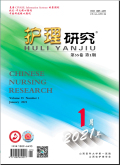护理研究2024,Vol.38Issue(1):24-30,7.DOI:10.12102/j.issn.1009-6493.2024.01.004
基于3种机器学习算法构建宫颈癌术后尿潴留风险预测模型
Construction of risk prediction model of postoperative urinary retention based on three machine learning algorithms
摘要
Abstract
Objective:To establish risk prediction model of postoperative urinary retention using decision tree,logistic regression and support vector machine and compare their performance,in order to provide references for evaluating and preventing urinary retention after radical resection.Methods:The medical history information of 459 patients who underwent radical resection in Shanghai First Maternal and Infant Health Hospital from 2018 to 2021 was collected retrospectively.Three machine learning models,decision tree,logistic regression and support vector machine,were used to construct the risk prediction model of postoperative urinary retention.Accuracy,recall,precision,F1 score and AUC were used to evaluate the performance of the models.Results:A total of eight variables were included,including age,disease stage,body mass index and so on.80%of data sets(367 cases)were selected as training sets and 20%(92 cases)were selected as test sets.The results showed that the accuracy,recall,precision,F1 and AUC of decision tree in the training set and test set were better than those of support vector machine and logistic regression,which indicated that decision tree had higher accuracy and better generalization performance.SVM was better than logistic regression in accuracy,recall,precision,F1 and AUC in the training set.At the same time,in the test sets,the recall and F1 of support vector machine were better than those of logistic regression;but the accuracy,precision and AUC of support vector machine were worse than those of logistic regression,indicating that the generalization ability of support vector machine was worse than that of logistic regression.Conclusion:Decision tree has high performance and generalization ability in constructing the risk prediction model of postoperative urinary retention,which can provide guidance and suggestions for related clinical behaviors.关键词
宫颈癌/尿潴留/危险因素/机器学习/预测模型/决策树/支持向量机/逻辑回归Key words
cervical cancer/urinary retention/risk factors/machine learning/prediction model/decision tree/support vector machine/Logistic regression引用本文复制引用
陆宇,江会..基于3种机器学习算法构建宫颈癌术后尿潴留风险预测模型[J].护理研究,2024,38(1):24-30,7.基金项目
上海申康医院发展中心管理研究项目,编号:2022SKMR-18 ()

